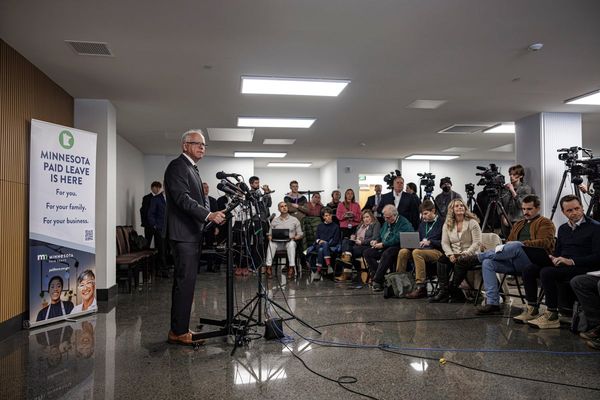In 2022, 45,755 men, women and children crossed the Channel in small boats to reach the UK, most of whom then claimed asylum. Nearly 3,000 people have already made the crossing this year, with official estimates expecting more than 80,000 this year.
Rishi Sunak has promised to end the small boats once and for all, by introducing the illegal immigration bill. Critics including former Tory ministers have claimed it is doomed to be halted by challenges in the European court of human rights and will be used as an issue to attack Labour in a general election campaign.
How does the bill fit in with existing human rights legislation and will it be challenged?
Suella Braverman on Tuesday was unable to confirm if the bill is compatible with the European convention on human rights. But the government inserted what is called a section 19(1)(b) statement into the bill, which indicates that the government intends to proceed.
Alexander Horne, a former parliamentary lawyer, described such a statement as a “big red flashing light”. He said: “Let’s say that this bill gets on the statute book and is found to be problematic. What you’re eventually doing is saying, well, the domestic courts will issue a declaration of incompatibility saying that this isn’t compatible with our convention rights but because it’s primary legislation they can’t overrule it, they just have to go along with it.
“So it will then go to Strasbourg because you’ve exhausted your domestic remedies and you’re effectively giving quite strong signalling to Strasbourg saying read the convention in this way or if you don’t, tonight, you’re setting up a conflict with the UK.”
Horne said the right to family life (article 8) was the most likely convention right to be the subject of a challenge but others were also possible such as the prohibition of degrading, inhuman treatment (article 3).
Charlie Whelton, policy and campaigns officer at Liberty, said the fact that in the past the government had not resorted to 19(1)(b) in the past “flags up that this will absolutely without any doubt whatsoever be challenged”.
But there remains the suspicion among lawyers that the government is setting up a confrontation with “lefty lawyers” and Strasbourg, who they can then blame for failure to implement the measures. Horne said it was highly unlikely to be on the statute books before the next election. “If you ask me, and this isn’t a legal opinion, it’s entirely a sort of political view, he [Rishi Sunak] is doing this to generate headlines,” he said. “I think the government thinks that banging on about Strasbourg is a new version of banging on about Europe.”
What routes are open to those seeking asylum in the UK?
Braverman’s aides have said that the bill leaves the way open to a new “global route” administered by the UNHCR.
Details remain scarce, but Braverman told MPs that an annual cap, to be determined by parliament, on the number of refugees the UK will resettle via safe and legal routes will be determined “once we’ve stopped the boats”. “This will ensure an orderly system, considering local authority capacity for housing, public services, and support,” she said.
To apply for asylum in the UK, applicants must be physically in the country under the current system.
In 2022, 1,185 refugees were resettled to the UK – 75% fewer than in 2019. Only 22 refugees came to the UK on the Afghan citizens resettlement scheme. There were also 4,473 refugee family reunion visas issued, down 40% on pre-Covid levels.
In comparison, in the last year more than 210,000 visas have been issued to people from Ukraine to travel to the UK. There are no Ukrainians recorded as having crossed the channel in a small boat.
Where would those who come by boat be detained?
The new law says that everyone who arrives in the UK via an irregular route – ie via small boats across the Channel or in the back of a lorry – will be detained for 28 days. Ministers are planning to convert a former RAF base in Essex and, according to the Times, another one in Lincolnshire.
But two new bases will not cope with the numbers of people who would be detained in the UK if this bill is enacted. Currently, people can be detained within the immigration system for the purposes of identification or when it’s going to be possible to remove them in a reasonable timeframe.
In 2022, a total of 20,446 people were detained at some point. Official statistics show that 47% were detained for seven days or less. The current detention capacity in the UK is about 2,286, according to estimates by the Refugee Council, so detaining everyone crossing in a small boat for 28 days would require extra capacity.
It would also be very expensive – it costs about £120 to detain someone for one day so detaining 65,000 people for 28 days would cost £219m a year, and that’s before the additional costs of building more detention centres.
Where would they be sent by the government under the new laws?
The bill, if enacted, will mean that anyone who arrives on a small boat will have their asylum claim deemed “inadmissible” – the Home Office won’t even consider someone’s claim, even if they’re from a war-torn country such as Afghanistan or Syria or if they face persecution such as women from Iran.
Instead, those people will be removed either to their own country or a “safe third country” if that’s not possible. What hasn’t been answered yet is where the tens of thousands of people who cross the Channel will be sent.
Half of the people who crossed the channel last year came from Afghanistan, Eritrea, Iran, Sudan or Syria. At least 80% of asylum claims from those countries are currently granted. For Afghanistan, Eritrea and Syria the figure is 98%.
Government aides say that at present, they plan to send a majority of those arriving by small boat to Rwanda, even though that scheme is being challenged in the courts. But even if it does start, it is only expected that about 200 people will be able to be transferred. There are no returns deals with France or the EU since the UK left the European Union.
What would happen to those people who can’t be removed?
The current process, which was introduced two years ago, states that a person’s asylum claim can only be deemed inadmissible if they could have or did claim asylum in another place, and the Home Office has been able to secure their removal to another country.
Of the 12,286 times the Home Office has tried to deem a claim inadmissible through that process, they’ve only been able to establish inadmissibility 83 times. That’s a “success” rate of just 0.7%.
If 65,000 people were to cross the channel once this new legislation was in place and all their claims were deemed inadmissible, that could mean 455 people would be removed on their current track record, according to figures from the Refugee Council.
That would leave 64,545 people stuck in limbo – unable to be removed, their asylum claims not being processed in the UK, unable to work or access support. The government has not yet said what would happen to them.
Government aides argue that there will not be thousands of people stuck in limbo because they predict an immediate drop in the numbers crossing the Channel if people are swiftly removed.
• This article was amended on 8 March 2023 because an earlier version referred to critics claiming that the bill is doomed to be halted “by challenges in the EU courts”. That meant to refer to the European court of human rights.







